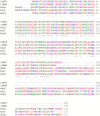Identification of a d-Arabinose-5-Phosphate Isomerase in the Gram-Positive Clostridium tetani
- PMID: 28630128
- PMCID: PMC5553037
- DOI: 10.1128/JB.00246-17
Identification of a d-Arabinose-5-Phosphate Isomerase in the Gram-Positive Clostridium tetani
Abstract
d-Arabinose-5-phosphate (A5P) isomerases (APIs) catalyze the interconversion of d-ribulose-5-phosphate and d-arabinose-5-phosphate. Various Gram-negative bacteria, such as the uropathogenic Escherichia coli strain CFT073, contain multiple API paralogs (KdsD, GutQ, KpsF, and c3406) that have been assigned various cellular functions. The d-arabinose-5-phosphate formed by these enzymes seems to play important roles in the biosynthesis of lipopolysaccharide (LPS) and group 2 K-antigen capsules, as well as in the regulation of the cellular d-glucitol uptake and uropathogenic infectivity/virulence. The genome of a Gram-positive pathogenic bacterium, Clostridium tetani, contains a gene encoding a putative API, C. tetani API (CtAPI), even though C. tetani lacks both LPS and capsid biosynthetic genes. To better understand the physiological role of d-arabinose-5-phosphate in this Gram-positive organism, recombinant CtAPI was purified and characterized. CtAPI displays biochemical characteristics similar to those of APIs from Gram-negative organisms and complements the API deficiency of an E. coli API knockout strain. Thus, CtAPI represents the first d-arabinose-5-phosphate isomerase to be identified and characterized from a Gram-positive bacterium.IMPORTANCE The genome of Clostridium tetani, a pathogenic Gram-positive bacterium and the causative agent of tetanus, contains a gene (the CtAPI gene) that shares high sequence similarity with those of genes encoding d-arabinose-5-phosphate isomerases. APIs play an important role within Gram-negative bacteria in d-arabinose-5-phosphate production for lipopolysaccharide biosynthesis, capsule formation, and regulation of cellular d-glucitol uptake. The significance of our research is in identifying and characterizing CtAPI, the first Gram-positive API. Our findings show that CtAPI is specific to the interconversion of arabinose-5-phosphate and ribulose-5-phosphate while having no activity with the other sugars and sugar phosphates tested. We have speculated a regulatory role for this API in C. tetani, an organism that does not produce lipopolysaccharide.
Keywords: Clostridium tetani; aldose-ketose isomerase; arabinose-5-phosphate; isomerase; kinetics; ribulose-5-phosphate.
Copyright © 2017 American Society for Microbiology.
Figures



References
MeSH terms
Substances
LinkOut - more resources
Full Text Sources
Other Literature Sources
Molecular Biology Databases

